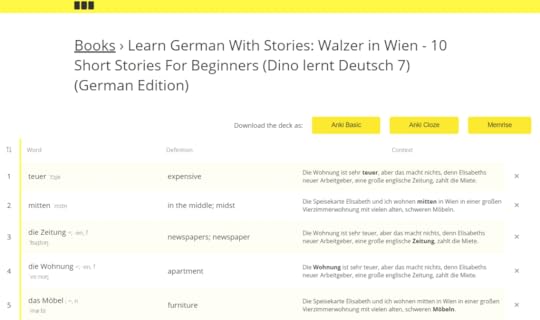André Klein's Blog, page 7
October 1, 2019
7 Tools To Help You Write In German
There are many ways to learn German, and they all have their pros and cons. Obviously, I’m a huge fan of learning German with stories. I believe it’s one of the most fun methods of acquiring new vocabulary and making it stick.
But if you don’t regularly maintain your treasure trove (we actually call it that: “Wortschatz” — word treasure) of words, phrases and expressions the slow rot of forgetfulness sets in and your hard-won vocab is first relegated to low-priority mental storage and eventually fully dropped from memory.
A very popular and efficient method to refresh and maintain your vocabulary is by using the “spaced repetition” method, for example by using flashcards. That’s why I’ve recently added free Anki & Quizlet cards s for all books in the Dino lernt Deutsch and Baumgartner & Momsen series.

But there’s another often-overlooked way to thoroughly nail down your vocab: writing. That’s right, by making these random bits and pieces of foreign word material your own you charge them with meaning, thereby prolonging their expiry date. It’s like telling your brain: “Hey, don’t delete that, I’m still using it!”
“Ready, Set, … Write!”
So how would you go about writing in German? Well, you could start writing a daily journal for yourself, compose your own little stories, short poems, write an email to a German-speaking friend — it all works, as long as you’re committed, so make sure to choose a goal you know you can complete.
Start small and work yourself up by integrating this practice into your daily learning routine. Perhaps at first you’ll write only one or two sentences per day, then later you’ll set your daily goal to something like 200-300 words. For this practice to bear fruit though, you’ll have to do it regularly.
Today I would like to share some tools with you to help you get started (and excel in) writing in German. Ready? Los geht’s!
Distraction Free Writing Apps
Since social media, apps and notifications started taking over our lives, calm focused concentration can sometimes be hard to come by. When you have too many windows open, too many popups, buttons and badges clamoring for your attention it’s so easy to get distracted!
This is why for almost a decade I’ve been doing all my writing (at least first drafts) in distraction-free writing apps and have been recommending them whenever I get the chance.
These apps are the antithesis to full-blown word processors like Microsoft Word. They strip away all the buttons, menus, etc. and reduce the process of writing to its bare and beautiful essence: putting one word after the other.

Declare War On Clutter & Reclaim Your Focus!
There are many apps like that but my favorite is iA Writer. It’s available for Mac, iOS, Android and Windows. It’s not free but affordable. They do offer trials though. For an excellent free alternative check out WriteMonkey (Windows) which I’ve been using for many years or Typora (Mac).
Quick Spell-Checking
Especially for beginners the process of writing in German can be daunting. It’s natural to constantly second-guess yourself when it comes to spelling and grammar, but it also takes you out of the flow, so I wouldn’t worry too much about it. Your first priority should always be to express yourself in German!
Once you’ve written a few words, you can always use the Duden Mentor tool to quickly give you some feedback about your spelling. The free version is limited to 800 words, but will suffice for most practice texts.
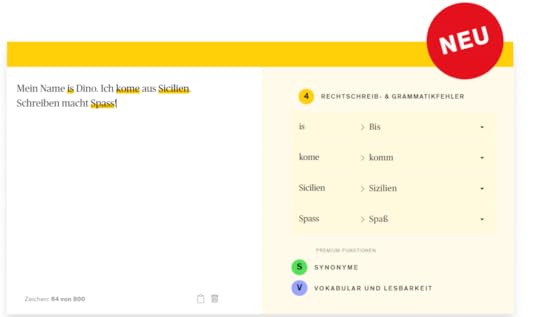
But What About Grammar?
Ja, ich weiß — German grammar can be notoriously difficult and there aren’t many good options when it comes to grammar checking tools. In fact, the only one I can wholeheartedly recommend is LanguageTool.
The Chrome/Firefox Extension, Google Docs Add-On, Standalone, Libre/OpenOffice extensions are all free, but they also provide a premium Word add-on. I haven’t tested the latter but the core functionality is really excellent, recognizing more than 2500 (!) error patterns from punctuation, declension to capitalization rules.
So many rules, right? But you don’t need to … rule them all (sorry for that). Anyhow, many native speakers don’t seem to have the faintest idea about may of these either, at least that’s the impression I get from comments on Facebook and Twitter. For shorter texts you can also use the LanguageTool website, no need to install anything.
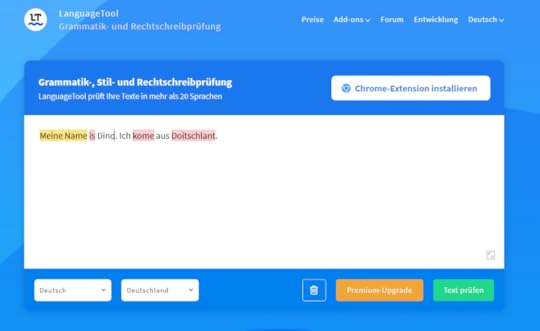
In this example, the tool correctly detected a grammatical incongruence (marked in yellow).
Style-Analysis & Statistics
Sometimes it can be helpful to analyze your writing, especially when your texts are getting more complex and you’re interested in polishing your style.
The Wortliga tool helps you avoid common issues such as over-use of passive voice, nominal style, impersonal language, overly long words, etc.
For a more quantitative statistical analysis, you can also use the Schreiblabor tool to find out exactly how many syllables, words, sentences, etc. you are using.
Killing Filler Words
Last but not least, there’s another fun little tool to help wipe fluff from your texts. Curiously it is based on a blacklist of German filler words by Goethe from 1817 (!) but when it comes to empty talk apparently not much has changed. This webtool can either delete these words or replace them with “XXX”.
Try it out here.
Obviously none of these tools described above are magic bullets. Writing is still hard work. At the end of the day these are just “dumb” programs checking your texts against lists of rules and common practices. Used judiciously however they can help you gain better insights into your writing and thereby slowly improve over time.
As I said before though, your first priority should always be the simple joy of writing, expressing yourself, making this new (and often confusing) language your own — word by word.
Have you incorporated a daily writing routine into to your German learning practice yet? How are you doing it, what tools do you find most helpful? Let us know in the comments.
–
The post 7 Tools To Help You Write In German appeared first on LearnOutLive.
September 3, 2019
NEW: Karneval in Köln Workbook (PDF)

Good news, everyone! Jeff Richards and I completed another workbook for the Dino lernt Deutsch series. This time we’re bringing you another 60+ pages packed with exercises, writing prompts, crossword puzzles and other activities for Karneval in Köln.
As with the previous two workbooks for Café in Berlin and Ferien in Frankfurt this comes to you completely free, in digital-only PDF format, ready for printing or just working on it with your tablet and stylus.
In order to get this (and the other workbooks) simply subscribe to our free newsletter. If you’re already subscribed, you should already have it by now!
If not, just hit the button below and you’ll get the Café in Berlin workbook first and then every few weeks the next workbook will land in your inbox, fully automated. Unless you want all of them together, in which case, just reply to the first email and we’ll hook you up.
As a little taster of what’s to come, Jeff also created a couple of exercises around a classic song which is played around the Cologne Carnival. The song is called “Der schmucke Prinz” and while it may not be everyone’s cup of tea musically speaking, it’s really a great way to immerse yourself in this strange tradition.
You don’t have to love marching band music for this. But, I guess … it helps?
Karneval • Der Prinz (Lied).pdf
The Carnival Season (also known as the “fifth season”) officially starts on 11/11, so now is actually a good time to start preparing.
Kölle Alaaf!
–
The post NEW: Karneval in Köln Workbook (PDF) appeared first on LearnOutLive.
May 15, 2019
NEW: Digital in Dresden Audiobook
The latest audiobook in the Dino lernt Deutsch series (episode 9) is finally here! After wrangling with soundwaves for a few weeks the audiobook is now complete and slowly rolling out to audio venues far and wide.
While I’m still waiting for it to make an appearance on Audible (yes, they are notoriously slow), it’s already available via Apple Books, Google Play, on CD (shiny!) and of course as a direct MP3 download from your favorite German learning story provider.
At 90+ minutes this is one of the longest stories in the series so far and I’ve made some improvements to my production workflow so you didn’t have to wait half an eternity again until I finally released the goods.
So without further ado … here’s Digital an Dresden for your ears! Join Dino on a strange adventure set in the “Florence on the Elbe”, boost your vocabulary and learn German effortlessly along the way.
Who needs textbooks anyway?
To get the most out of this audiobook I highly recommend going through the vocabulary and comprehension questions contained in the ebook and paperback edition.
The post NEW: Digital in Dresden Audiobook appeared first on LearnOutLive.
March 23, 2019
German Spelling Made Easy With Duden Spellchecker & Grammar Checker

Did you know that 100 years ago German spelling was a highly fragmented endeavor? People just spelled how they felt like, and with all the different dialects and varieties that resulted in wildly different outcomes, which made for a lot of misunderstandings.

Mr. Duden
All of this Schlamassel was fixed by the now-famous teacher Konrad Duden who came up with core spelling principles and guidelines so that people from Munich could finally make sense of their letters from Hamburg, and vice versa. Today his name is synonymous with good German spelling and “der Duden” orthography books have pretty much become the German bible of spelling.
But German spelling is far from being fixed. There have been multiple reforms within the last few decades (last one in 2017) and many spellings I learned in school for example, are now simply wrong:
false/not recommended
correct/recommended
Delphin
Delfin
Photograph
Fotograf
Schrittempo
Schritttempo
gestern/heute/morgen Abend
gestern/heute/morgen abend
Fluß
Fluss
Recht haben
recht haben
Confused? It’s understandable. There are a myriad of different rules for German spelling, capitalization, correct comma placement, etc. (core grammar rules aside). While there aren’t as many good resources for German grammar/spelling online as for English, there are a couple of (free) online tools you can use to make the process of writing correct German a little bit easier.
Duden.de
The official online version of the Duden is the authoritative source for looking up spelling variants, conjugations, etc. Sometimes multiple spellings are correct but Duden will show a “empfohlene Schreibung”, i.e. “recommended spelling”.
They will also provide you with good examples and explanations why something is correct or when. The only downside for beginners may be that the website and its explanations are in German.
LanguageTool
If you’re checking a ton of words, manually going to Duden.de will be exhausting, so here’s an automated German spellchecker: with LanguageTool you can just run your whole text through more than 2200 error patterns.
It finds even finds (some) grammar mistakes and is compliant with the latest Duden rules. And the best: it’s free (mostly). The LanguageTool spell checker comes in the following versions:
LibreOffice/OpenOffice Extension (free)*
Chrome/Firefox Extension (free)
Google Docs Add-On (free)
Microsoft Word add-on (premium)*
Standalone Software (free)*
For me, LanguageTool has become an invaluable, well … tool for helping me identify and fix errors faster and more seamlessly. It also works for other languages like English, but it has a specific focus on German.
/* DivTable.com */ .divTable{ display: table; width: 100%; } .divTableRow { display: table-row; } .divTableHeading { background-color: #EEE; display: table-header-group; } .divTableCell, .divTableHead { border: 1px solid #999999; display: table-cell; padding: 3px 10px; } .divTableHeading { background-color: #EEE; display: table-header-group; font-weight: bold; } .divTableFoot { background-color: #EEE; display: table-footer-group; font-weight: bold; } .divTableBody { display: table-row-group; }
The post German Spelling Made Easy With Duden Spellchecker & Grammar Checker appeared first on LearnOutLive.
March 17, 2019
NEW: Dino lernt Deutsch Episode 10: Schlamassel in Stuttgart
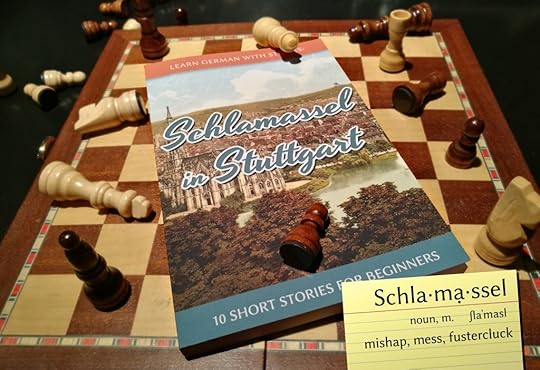
In case you missed it on the newsletter, there’s a brand new Dino lernt Deutsch episode! That’s right, episode 10 is out now and this time Dino is going to Stuttgart, Germany’s 6th largest city, capital of Baden-Württemberg and home to Mercedes-Benz.
Ready for your next German learning adventure?
In this sequel to Digital in Dresden Dino and Elisabeth are invited to a prestigious event, but when nothing goes as planned they find themselves hurled on a strange quest across the valley basin of Stuttgart.
Explore Stuttgart, learn about local culture, history and cuisine, and improve your German effortlessly along the way — in this new set of 10 connected German short stories for beginners.
Kindle Edition (Amazon US / UK / DE)
Paperback Edition (Amazon US / UK / DE)
MOBI/EPUB/PDF (DRM-free)
Apple Books
Nook
The post NEW: Dino lernt Deutsch Episode 10: Schlamassel in Stuttgart appeared first on LearnOutLive.
January 13, 2019
How To Create ANKI Flashcards From Your Kindle Vocabulary Builder

The Vocabulary Builder on Kindle Paperwhite (and Oasis, Voyager) is a powerful feature for language learners if used right. It collects all the words that you look up, including their definition and context. You can then use a rudimentary flashcard system and group them into “learning” and “mastered”. However, for serious spaced repetition practice, the Kindle Vocabulary Builder lacks certain fine-grained controls.
Wouldn’t it be cool if you could just convert your Kindle vocabulary to ANKI or Memrise flashcard format?
Well, you can, thanks to this amazing free service called “Fluentcards”.
Here’s how it works:
1. Collecting Words On Your Vocabulary List
The Kindle vocabulary builder will add any word you look up (long press on it) to you vocabulary list. By default, if you look up English words in an English text it will save the corresponding entry from the English-English dictionary. So, if you’re reading a foreign-language book and want to get, let’s say, German-English vocabulary lists, make sure to select the correct dictionary in your settings.
Settings > Language & Dictionaries > Dictionaries
There you can select which default dictionary you’d like to use for each language. In the following example, I’ve selected the Collins Concise German-English dictionary.

Now that you’ve selected your default dictionary for this language, open your favorite German short story or novel and start looking up words.

2. Exporting Your Vocabulary File
Once you’ve gone through the whole book, story or chapter, we need to get the Kindle vocabulary file onto a computer. To do this, hook your Kindle Paperwhite up to your Mac or Windows machine, open the corresponding disk drive and search for the vocab.db file.
Here’s how it looks on Windows:

If you don’t find the file, you may have to change your settings to show hidden files and folders.
For Mac users, you’ll see something like this:

If you can’t see the file, you may have to enable hidden files and folders like this.
3. Converting Your Vocabulary List To ANKI or Memrise
Once you’ve copied the vocab.db file to your computer, go to fluentcards.com/kindle and upload your word list there. Fluentcards will show you a nice gallery of all your books and the words you looked up in each of them. In our example you can see that I’ve looked up 5 words in “Walzer in Wien”:

Once you click on a title you get a complete listing of all the words, their definition (translation) and context:
That’s it!
Now you can simply download this deck in ANKI or Memrise format and use it within your favorite spaced repetition app.
Here’s how it looks in the ANKI app for PC, for example:
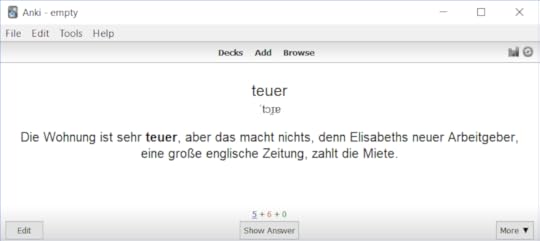
By combining the swift collection of vocabulary on your Kindle with ANKI spaced repetition, you got yourself a lean-mean-learning-machine. So far, this feature is only available on (some) physical Kindle ereading devices, but hopefully Amazon will make it available for their Kindle apps on iOS and Android at some point in the future.
–
The post How To Create ANKI Flashcards From Your Kindle Vocabulary Builder appeared first on LearnOutLive.
December 17, 2018
1929: The Year Babylon (Documentary)

Did you enjoy Babylon Berlin, the critically acclaimed German TV series? Perhaps even used it to boost your German listening skills? If you’ve ever wondered about the historical accuracy of the series there’s a great documentary which aims to provide some context around the year in which the event of the series take place.
1929: Das Jahr Babylon (“The Year Babylon”) presents the year 1929 as a time of immanent crisis. The first world war has ended about ten years ago, the defeat is all but forgotten, the future is unsure and the young republic in a constant state of emergency.
Through the use old journals, memories, police reports, newspaper snippets and other contemporary documents, narrated by some of the original actors (Fritzi Haberlandt, Leonie Benesch, Peter Kurth, Anton von Luck) from Babylon Berlin, this film paints an immersive picture of a tumultuous time in the German capital between two terrible wars.
Last but not least the documentary is scored by legendary Swiss producer/composer Thomas Fehlmann who wraps the dramatic reenactments and historical footage in his haunting electronic landscapes.
You can watch Das Jahr Babylon on ARD in full length (with German subtitles) until the 30th of September 2019 or on YouTube:
The full score by Thomas Fehlmann is also on Spotify:
The post 1929: The Year Babylon (Documentary) appeared first on LearnOutLive.
December 10, 2018
Howdy! This is Texas German
Have you ever wondered how many German dialects there are? Between the breezy Northern Platt and the homely Southern Boarisch, it’s actually quite difficult to come up with a definite number. Theoretically there are as many dialects as there are German speakers.
Especially when you travel farther away from Europe, it’s remarkable how local communities over time created their very own dialects which preserved certain parts of Standard German (dialects) but also branched off in unique ways. Many of you may have heard about Pennsylvania German, for example, but did you know that the Lone Star State has its own German dialect too?
The post Howdy! This is Texas German appeared first on LearnOutLive.
October 26, 2018
Introducing: The Bookshop Redesign

It’s the year 2018. We still don’t have flying cars, but Wikipedia lists more than 30 different ebook file formats.
As much as I love to read (and create) ebooks, there are so many different competing formats and platforms out there that it can sometimes get a bit confusing.
What’s the difference between PDF and ebook formats? Do I need MOBI or EPUB? How do I move a book from my Kindle to an iPad? And why can’t all of this be simple? I don’t want to fly to Mars! I just want to read!
Don’t know what I’m talking about?
Well, if you get your ebooks from one of the Big Stores, such as the Kindle Store or the iBookStore you’re lucky, in a sense, because you don’t have to deal with any of this. You just click that chunky purchase button and the book automagically appears on your device. *poof*
But! Getting your books from these big stores also means that you have limited control over your purchases. Want to share a title with a friend who’s on a different platform? You’re out of luck. Feel like quickly copying your book collection onto a thumb drive to secure them for offline use? Nope.
Freedom vs Convenience
Don’t get me wrong, I love the convenience of the Kindle Store and I’m reading more than ever, but I also think a customer should have full control over her digital purchases. After all, if you bought it, it should be up to you how you read it, share it, store it, no?
This is why for a couple of years now I’ve been distributing my books on the Big Stores like Amazon and iTunes, but on LearnOutLive I’ve also offered you direct access to the ebook files, no questions asked.
But there was a tiny problem.
That’s right. File formats. Especially …
ZIP: My Problem Child
 I offered all my books as ZIP archives, neatly packaged containers with all the various ebook file formats inside. Turns out though that mobile Apple devices make it nearly impossible to open them.
I offered all my books as ZIP archives, neatly packaged containers with all the various ebook file formats inside. Turns out though that mobile Apple devices make it nearly impossible to open them.
For example, I’ve had people writing to me from the airport where they purchased a book from their shiny new iPhone in hope of reading it on their upcoming flight, only to be greeted by Apples ZIPophobia.
But even if your devices were not opposed to that sturdy dinosaur of archives (ZIP was invented in 1989 by the way) some people still found it too cumbersome. And I get it. When we purchase something we expect it to work immediately, no assembly required. (Those big stores sure taught us well!)
For a while now I’ve been thinking about how to solve this problem. And I believe I’ve finally found a way to make all of this a bit easier and more convenient while still keeping the freedom that comes with actually owning your own files.
More Choices, Better Design
First of all, when you now make purchases on the book shop, you don’t just get a ZIP download, you also get direct access to the contents of said container, i.e. if you’re on a device that doesn’t like ZIPs, or you just don’t feel comfortable with the concept of file systems in general, you can simply pick and open the book directly from your device.
Also, I’ve made the design of the customer area a bit more user-friendly so you can distinguish the various books and formats more easily.
So, without further ado. Here’s how it used to look:
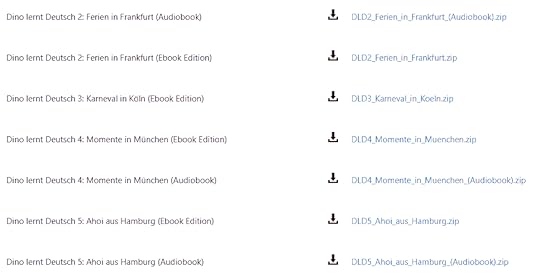
Functional, but not pretty. Aaaand, this is how it looks now:

As you can see, each book download is now listed with its cover image, the original ZIP and all of the contained ebook formats, including the flashcards.
But that’s not all!
I’ve applied the same treatment to all the audiobooks so that if you can’t or don’t want to deal with ZIPs, you can stream the MP3s right from your browser (internet connection required).

(This is still very rudimentary, but at least it works on all devices I’ve tested it on.)
Want to check it our for yourself? Go to your account area and log in! Or if you don’t own any books yet, perhaps now is the perfect time to fill up that cart. *wink wink, nudge nudge*
Use coupon code EBOOKSHMEEBOOK during checkout to get 20% off (valid until 31st October).
–
This post originally appeared on the Learn German with Stories newsletter
.screencard {box-shadow: 0 1px 3px rgba(0,0,0,.12), 0 1px 2px rgba(0,0,0,.24);border-radius: initial;padding: 22px;}
The post Introducing: The Bookshop Redesign appeared first on LearnOutLive.
October 8, 2018
Tips & Strategies For Learning German With Stories

Learning German with stories can be a great way to expand your vocabulary, boost your passive grammar skills and get a general feel for the language, all while enjoying a (hopefully) entertaining yarn.
But how to do it the best way? Preparing vocabulary first? Or just dive right in? Today I’d like to share a few tips & strategies with you that’ll make your reading training even more effective:
1. Pick Something That Strikes Your Fancy
This may sound obvious but I can’t emphasize it enough. If you want to get the most out of reading a story, you should be really interested in the setting, characters, plot, etc. This interest is the fuel that’ll help you churn through any challenges you’ll (inevitably) encounter in the text. Put simply, don’t try reading something you wouldn’t find interesting in your mother tongue.
Secondly, your reading material should obviously be at the right difficulty level, but in case of doubt I’d always recommend to rather read something slightly more difficult that excites you than something easier that bores you.
Many people try reading children’s stories in the beginning, but the learning effect dwindles quickly since these stories aren’t meant to engage adult readers. And once your attention slips away, so do the benefits.
Need something interesting to read in German? Here’s a quick list of resources to help you get started:
German short stories from the post-war era
fairytales and other simple stories
German graphic novels and comics
literary German novels which are (relatively) accessible
 Note: Most of these materials weren’t written for learners but native speakers. If you’re looking for stories which are specifically designed for German learners and include vocabulary and comprehension quizzes, check out our bookshop.
Note: Most of these materials weren’t written for learners but native speakers. If you’re looking for stories which are specifically designed for German learners and include vocabulary and comprehension quizzes, check out our bookshop.
2. Read, Rinse & Repeat
Now that you’ve chosen a text that a) interests you, and b) is at the right difficulty level, it’s time to start reading. But in what manner exactly? Quickly? Slowly? Skimmingly? Thoroughly?
Here are a few key aspects to consider and some general guidelines:
Looking Up Words
 Maybe you make it through the first part of the first sentence before you encounter your first U.V.O. (unidentified vocabulary object), maybe it’s even the first word of the story. Should you look it up immediately and note it down?
Maybe you make it through the first part of the first sentence before you encounter your first U.V.O. (unidentified vocabulary object), maybe it’s even the first word of the story. Should you look it up immediately and note it down?
If you’ve read my books you’ll know that I generally advise students not to be too eager to look up each and every word immediately. Because when you check every second or third word you’re not reading any longer, you’re just flipping through a dictionary, which defeats the purpose.
As a rule of thumb, if you think you get the gist of a sentence despite the UVOs, don’t look them up immediately. You can always check them later. Just keep reading. Only if the sentence (and the next) fail to make any sense at all, or certain key words keep popping up again and again, look them up and note them down on your first read.
The exact ratio of looking up vs. ignoring depends on a lot of different factors (reading skills, text difficulty, etc.) but after a while you should be able to settle into a balance that suits you.
See also: 5 Best German-English Dictionaries Online, Offline, Apps & Add-Ons
Reading Plans & Repetitions
Another important aspect of reading stories as part of your language learning routine is this: repetition. It doesn’t seem attractive, I know. It even sounds a bit boring, doesn’t it? Why read something again if you’ve already (kind of) understood it. But don’t be mistaken! Repeated readings of a section/chapter will yield huge rewards when done correctly.
Some people create elaborate reading plans for themselves where on day one they read chapters 1, 2, 3, on day two chapters 2, 3, 4, on day three 3, 4, 5, etc. It doesn’t really matter as long as you’re persistent and keep repeating certain parts while moving forward.
Adding an audio version to the mix can also be helpful. For example, redditor Henkkles describes his strategy as follows:
“This circle has three passes for each chapter, so for example on the first one you read the chapter while you listen, making note of new vocab. On the second pass you only listen to it, pausing when your comprehension falters and checking the book. On the third pass you’ll only listen to the chapter or listen and repeat, or whatever it is that tickles your fancy. You may adapt this as you see fit.”
So, whether you study a chapter every day for 20 minutes, or two chapters every day for 40 minutes, it all depends on how much time & motivation you got to spare. I’d recommend finding a rhythm that keeps you challenged without putting too much of a strain on you. If it start to feel like a chore, just stop and adjust your schedule.
During repeated readings, feel free to look up more words and note them down. But as another redditor noted: “don’t dwell on a chapter until you understand everything. don’t even dwell until you’ve learned 2/3rds. That’s the best way to drive yourself crazy.” (sic)
3. Retain & Reinforce
After having found a reading schedule that allows for a good reading flow and a certain amount of repetition it’s time to make sure that all of those new words you learned will make it into your long-term memory and not get washed out.
Flashcards are an excellent time-tested method of storing new knowledge, and whether you create your own paper cards or use a digital system, it simply works! (Note: I’ve created free flashcards for all Dino lernt Deutsch books that ship with the digital downloads.)
Additionally, you could also “gamify” your learning routine. For example, Quizlet(where I also uploaded all the above flashcards) offers various learning games that help you make memorization just a little bit more fun.
If you don’t like flashcards or games, another good way to memorize words is by using them, either in spoken or written form. Here’s a quick exercise: start by selecting 5-10 words from your vocabulary list and work them into a little text (~250 words), perhaps your own little spin-off story?
–
The post Tips & Strategies For Learning German With Stories appeared first on LearnOutLive.






